Vintage Paddles and Gigs – Nautical Memorabilia – A Celebration of this Seasons Surf Boat Carnivals

A Vintage canoe paddle that adorns the 'men's shed' here.
Many residents have a passion for wooden vessels you can get from A to B in just by paddling. The collecting of paddles, old surfboats and associated accoutrements brings a bit of the old briny into your own home and yard. Some of these paddles, such as the one that forms part of our collection, now fetch high prices from avid collectors. Others, belonging in museums, share an insight into the centuries old mode of transport dubbed ‘rowing your own boat’.
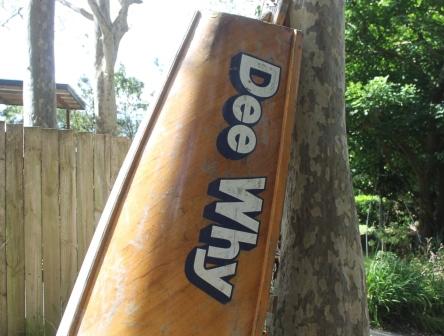 Our neighbours have what’s left of an old Dee Why boat, beautifully constructed and still standing up to all weathers just to bring a bit of soft sea lapping to their yard.
Our neighbours have what’s left of an old Dee Why boat, beautifully constructed and still standing up to all weathers just to bring a bit of soft sea lapping to their yard.
With the last Surf Life Saving Sydney Northern Beaches Boat Events forming part of the Branch Championships next Saturday, February 14th, at Palm Beach, and triple points on offer (see current point score HERE - PDF 243 kb), and the Pittwater Festival run by the Royal Motor Yacht Club of Broken Bay again hosting a surf boat shoot on calmer waters as the last event of this year’s festivities, a small look into where rowing events began in Sydney is our way of celebrating all the great surf boat carnivals we’ve followed this season, and some of the chunks of wood fashioned into aquatic usefulness that lingers in our collection of ‘just about anything’.
Rowing as a sport began quite early in Sydney, a race as the first officially recorded one being that of 16th of May, 1818, between crews from three ships, the Batavia, the Guildford and the Minerva, and a crew formed by Captain John Piper, with him in charge, for "a considerable sum" and was won by Captain Piper's crew.
The first Australian Regatta, held on Sydney Harbour, included a large programme of rowing races, which we covered in a page we ran last year: 2014 – The 178th Australia Day Regatta began as Anniversary Day Regatta
An extract from that 1827 Regatta report:
The First Australian Regatta.
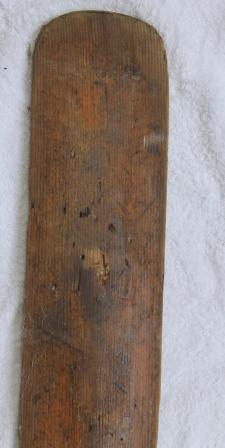 Saturday was fixed on, as it closed the week, to conclude the week's sports. Under the auspices of Captains STIRLING and Rous, of H. M. ships Success and Rainbow, three aquatic Races were set on foot, and time just allows the enumeration of these novel but highly interesting, and comparatively innocent amusements.
Saturday was fixed on, as it closed the week, to conclude the week's sports. Under the auspices of Captains STIRLING and Rous, of H. M. ships Success and Rainbow, three aquatic Races were set on foot, and time just allows the enumeration of these novel but highly interesting, and comparatively innocent amusements.
The first Race was a Rowing Match for Sweepstakes of 20 Spanish dollars, for which the following boats started :-Captain Rous' Mercury; Captain Rous' Centipede; Lieutenant Carnac's Maria ; Mr. Scott's Australian Lass; Lieutenant Cooling's Cock-burn; and Colonel Dumaresq's Fancy.
A preparative gun was fired from the Success a few minutes after 12, for the various antagonists to assemble; and, in ten minutes after, the discharge of a second gun gave the signal for action. They started from Sydney Cove, and rounded a boat moored off Pinchgut Island, which they passed from the Southward to the Northward, and ended off Sydney. This Race was cleverly won by the Mercury, belonging to the Honorable Captain Rous; and when she came in, the yards of the Success being manned, the naval heroes gave three cheers; the Band of the 57th at the same time striking up cheerily.
The second Race was a Sailing Match for a Purse of 50 Spanish dollars, given by the Officers of H. M. ships Success and Rainbow, added to a Sweepstakes of 5 dollars each. About two a similar signal was given from the Success, and the following boats started a short time after:
Captain Rous' Australia; Lieutenant, Cooling's Ro Reby ; Mr. Milroy's Ellen; Mr. Gray's Go-along; Mr. Nicholson's Hannah; Mr. Egan's Australian; Mr. J. Campbell's Model; and Captain Barnett's Rosanna. The prescribed distance was to go round the Sow-and-Pigs. The wind was rather light, which made against some of the boat's. The victory, however, was gained by Lieutenant Preston's Black Swan.
The third Race was a Rowing Match, for 20 Spanish Dollars, given by the Officers of H. M. Ships Success and Rainbow. Eight boats started for the prize, taking their departure from Dawes' Point, rounding Pinch-gut Island, and returning to the place whence they set out. It was won by Black Boy. ,,,
The Success and Rainbow were crowded with Ladies and Gentlemen. On board the former ship, the Band of the 57th was adding to the interest of the scene, and the Ladies during the intervals of the Races, were engaged by the gentlemen to while away the lingering moments on " the light fantastic toe." Captains STIRLING and ROUS, as well us their Officers, did all in their power to contribute to the happiness of their guests, especially the Ladies, of whom there was no small number.
Dawes' Point and Macquarie Fort were crowded with spectators of all ranks and denominations. The harbour was thickly strewed with floating vehicles of all shapes, dimensions, and colours. In fact it does not come within our recollection that such another gratifying exhibition presented itself to the view of the Australian Public, since the day that venerated MACQUARIE for ever bid adieu to the rising empire of Australia.
Ere we close, it is nothing more than justice to add, that Mr. Nicholson, the worthy Master Attendant, who was appointed Judge for the day, is amply entitled to the thanks of all who were gratified, for the trouble and interest he took in promoting and executing the pleasures of the day. The First Australian Regatta. (1827, April 30). The Sydney Gazette and New South Wales Advertiser (NSW : 1803 - 1842), p. 2. Retrieved from http://nla.gov.au/nla.news-article2188128
These rowboats were called, and still are, ‘gig’s.
Wooden captains' gigs … during the era of wooden ships, a gig was smaller and lighter than the longboat, barge or pinnace. It was usually crewed by four oarsmen, and a coxswain. Generally the oarsmen sat one to a seat, but each only rowed a single oar on alternating sides. The gig was not as sea kindly as the longboat, but was used mostly in harbours.
The gigs generally had a high wineglass transom, full skeg, full keel, straight stem and somewhat rounded sides. There was in general very little rocker in the keel. The gunwales on many were nearly straight from bow to stern. Gigs appear to be the precursor to the Whitehall Rowboat. Some wooden captain's gigs were quite large and were powered by sail. (1)
Open whalers were also very popular for rowing races, and many point to these as the forerunners of the surf boats we see today. In 1833 a Sydney crew met and defeated a Hobart crew in whalers – this was considered the first inter-colonial rowing race:
We are much pleased to observe the rivalship in aquatics existing between this and the sister colony. Mr. Arthur Frankland, a gentleman from Hobart Town in order to take the shine out of our corn-stalks sent purposely for his boat, and bade defiance to the colony. The natives took up the gauntlet, and the Fair Jane was named. The Dispatch the first boat in the Derwent, was manned by a select crew, and steered by the veteran Cadman. The Fair Jane had a native crew, and was steered by Mr. Maughan. From the commencement of the race, the feeling of success was decidedly in favour of the Currency Lads. They maintained the lead from the starting to the end of the race. Cadman did his best, and his rowers stood manfully to their oars. The distance is 9 miles, and it was performed as under :—
Fair Jane—47 minutes—55 seconds.
Dispatch—40 minutes—57 seconds.
Difference 1 2. ADVANCE AUSTRALIA Sydney Gazette. (1833, November 9).The Sydney Gazette and New South Wales Advertiser(NSW : 1803 - 1842), p. 2. Retrieved from http://nla.gov.au/nla.news-article2214752
The sport of rowing grew more and more popular, for both competitors and those who would watch these Regattas. In March of 1859 the "Australian Subscription Boat Club" was established in Sydney, on the eastern side of Woolloomooloo Bay.
Advertisements in the Freeman’s Journal announced that:
AUSTRALIAN SUBSCRIPTION BOAT CLUB — Established on the principle of Searle's celebrated Boat Club on the River Thames. Gentlemen can, by the payment of a moderate subscription, quarterly in advance, obtain at anytime Pleasure or Fishing Boats, Skiffs, Gigs, Eight Oared Cutters, Funnies, &c, &c. ; also have the free use of the spacious Club Room, to which will be attached Coffee and Dressing Rooms. Provisional Committee: —George Thornton, Esq., M.P.F. J. Hilley, Esq. R. Driver, junior, Esq. John Williams, Esq., J. P. R. Harnett, Esq. J. Josephson, Esq. To whom all applications for Membership and copies of the rules must be addressed, under cover to P.R. HOLDSWORTH, Acting Manager. Woolloomooloo and Circular Quay. 255 Advertising. (1859, May 11). Freeman's Journal(Sydney, NSW : 1850 - 1932), p. 1. Retrieved from http://nla.gov.au/nla.news-article115559840
AQUATICS - It will be seen by an advertisement that a club has been established, called " The Australian Subscription Boat Club," The object, we are Informed, is to encourage aquatic sports for amateur racing; also, to enable the members of the club to have the use of boats of all kinds and classes, at any time they may require them, instead of being, as at present, compelled to keep their own boat, at much trouble and expense. Club rooms are to be built at the end of Potts' Point, to which will be attached coffee and dressing rooms, provided with books, chess, and other amusements. MAILS BY THE EMEU. (1859, March 9). The Sydney Morning Herald (NSW : 1842 - 1954), p. 4. Retrieved from http://nla.gov.au/nla.news-article28631712
George Thornton, Esq., M.P., was a gentleman known for being a pillar of rowing in New South Wales.
The oldest of Australian rowing clubs still in existence was also founded in 1859. This, the Melbourne University Boat Club, is attributed by many to Professor M. H. Irving, a keen English rowing man who accepted a chair at Melbourne University in 1855.
By 1860 three classes of rowers competed and were classified as professionals, manual labourers who rowed for money, and gentlemen amateurs who also rowed for money prizes.
On 5 March, 1870, the following advertisement appeared in the Sydney Morning Herald:
"Rowing Association. - A Meeting interested in the advancement of amateur rowing and the formation of a Rowing Association, will be held on Monday next, at half-past 7 p.m., at the Oxford Hotel, King-street. Henry Freeman, Hon. Secretary pro tem."
On Monday the 7th, the meeting was duly held and, next day, the Herald reported that "the Sydney Amateur Rowing Club may now be considered an established affair".
The meeting was attended by twenty-five gentlemen and "every one present was unanimously of opinion that the formation of a club for the purpose of improving and encouraging amateur rowers was much needed in Sydney".
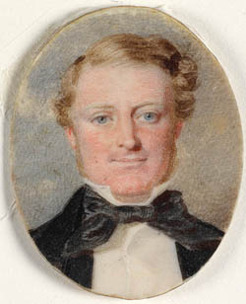 George Thornton was to have chaired the meeting but couldn't stay and Freeman took over. In due course he was made the first President of this club.
George Thornton was to have chaired the meeting but couldn't stay and Freeman took over. In due course he was made the first President of this club.
George Thornton was born in Sydney in December, 1819 and, after starting work in the customs house, successfully branched out on his own as a shipping and customs agent. He became a city councillor in 1848 and subsequently Mayor, his first act being to agitate successfully for removal from the streets of Sydney of "those barbarous relics of old-time punishment", the stocks and pillory.
Mr Thornton was elected to Parliament several times. Apart from being an excellent swimmer, taking a dip each morning at Manly, he was very interested in sailing as well as rowing and took pride in having taken part in the first ‘Anniversary Regatta’ of 1837.
Historians state Mr. Thornton used to delight in recalling his role in the production of the first issue of the Sydney Morning Herald in April, 1831.
His reminiscences state, when setting the type, the compositors were left in the dark as their candles burnt out. The overseer sent over to the nearby home of Mr. Thornton, Sen., for more light. Young George was entrusted with three candlesticks and tallow candles, through which the first issue of the Herald was set.
Picture: George Thornton, by William Nicholas, 1852 courtesy State Library of New South Wales.
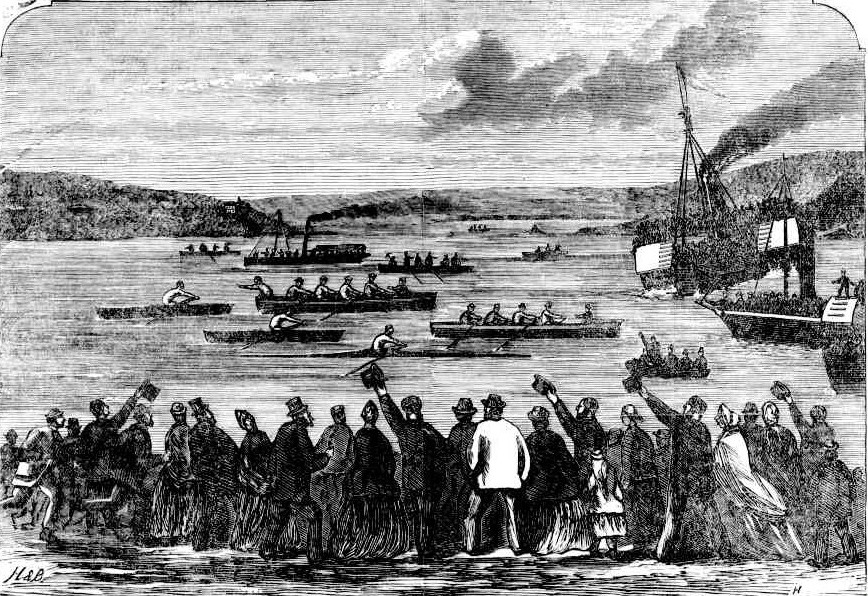
GREAT SCULLER'S MATCH ON THE PARRAMATTA RIVER. Great Sculler's Race.-Hickey v. Rush. ON Saturday afternoon the skill, endurance, and courage of two "of the finest rowers in Australian waters were tested on the regular course on the Parramatta River, when R. Hickey and Rush met to decide as to which was the superior man in watermen's boats, the rich stake of £500 being also involved in the contest. Great Sculler's Race.—Hickey v. Rush. (1870, May 28).Australian Town and Country Journal (Sydney, NSW : 1870 - 1907), p. 24. Retrieved from http://nla.gov.au/nla.news-article70459834
In 1872 another official inter-colonial rowing race took place, on the Derwent in Hobart, with one of the crew members being future prime minister of Australia, Edmund Barton:
With reference to this race, which is creating great interest in aquatic circles, we understand that as many as seven crews are likely to contest for the grand intercolonial prize,to be rowed for in four-oared gigs on the Derwent, on the 30th inst Two of the crews have already taken their departure from Sydney-one from the Sydney Bowing Club, the other called the " River crew." It is also said that there will be two Hobart Town crews, one from New Norfolk, and one from H.M.S. Clio. The Geelong crew left yesterday by the steamer Derwent. for Launceston en route to Hobart Town. They are accompanied by an emergency man, Sydney Edwards a coxswain, and Mr. James Edwards, the well-known boatbuilder. We learn by telegram that the boat used by one of the Sydney crews sustained some damage in consequence of being struck by a sea. It is to be hoped that no such unpleasant contretemps will occur on the day of the race. GRAND INTERCOLONIAL FOUROARED RACE, AT HOBART TOWN. (1872, January 20). The Australasian (Melbourne, Vic. : 1864 - 1946), p. 12. Retrieved from http://nla.gov.au/nla.news-article138087975
THE INTERCOLONIAL CHAMPION GIG RACE.
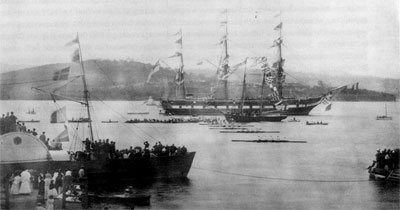 Some changes having recently taken place in the crews that have entered to compete in the Inter-colonial Champion Gig Race at the Annual Regatta, to be held on the 30th inst., we publish the names of each crew as it is now understood they will row. The changes that have taken place are as follow :-In the Hobart Town Heavy Crew R. Barnes takes the place of J. W. Dodds, who has been compelled to retire, owing to ill health ; in the Sydney Rowing Club Crew Mr. G. H. Fitzhardinge is under medical treatment for an attack of quinsy, and in consequence this crew have fallen back on their emergency man, J. E. Meyers. The following are the crews given in the same order as the entries were received:
Some changes having recently taken place in the crews that have entered to compete in the Inter-colonial Champion Gig Race at the Annual Regatta, to be held on the 30th inst., we publish the names of each crew as it is now understood they will row. The changes that have taken place are as follow :-In the Hobart Town Heavy Crew R. Barnes takes the place of J. W. Dodds, who has been compelled to retire, owing to ill health ; in the Sydney Rowing Club Crew Mr. G. H. Fitzhardinge is under medical treatment for an attack of quinsy, and in consequence this crew have fallen back on their emergency man, J. E. Meyers. The following are the crews given in the same order as the entries were received:
1. Barwon Rowing Club's Crew, Gig " Victoria"-E. Nicholls (bow), C. Shannon, J. F. Strachan, J.Cullen (stroke), J. Ogilvie (coxswain), J. Arthur(emergency man).
2. Parramatta River Crew, Gig; "Osprey."-F. H. Williams (bow), E. H. Barton, R. B. Hays, J. G. Blaxland (stroke), J. Miller (coxswain), C. Barton(emergency man).
3. Hobart Town Heavy Crew, Gig " Satanella."-R. Barnes (bow), H. E. Best, C. W. Gaylor, F. W.Abbott (stroke), J. Hopwood (coxswain).
4. Hobart Town Light Crew, Gig " Fireflash."-W. B. Jones (bow), H. Radcliffe, G. Penny, F. Norman(stroke), A. Humphreys (coxswain).
5. Sydney Rowing Club's Crew, Gig " Sydney Rowing Club."-C. de B. Deloitte (bow), J. E. Meyers, R. A. Clark, M. A. H. Fitzhardinge (stroke), L.McKay (coxswain).
As yet there is but little betting on the event, but many regard the Barwon Rowing Club's crew as the favourites. THE INTERCOLONIAL CHAMPION GIG RACE. (1872, January 24). The Mercury (Hobart, Tas. : 1860 - 1954), p. 2. Retrieved from http://nla.gov.au/nla.news-article8920740
The two Sydney crews won in these Cuthbert made, Green designed gigs. Read how much excitement this race roused in Sydney, and a little about Mr Cuthbert, in Extras (below).
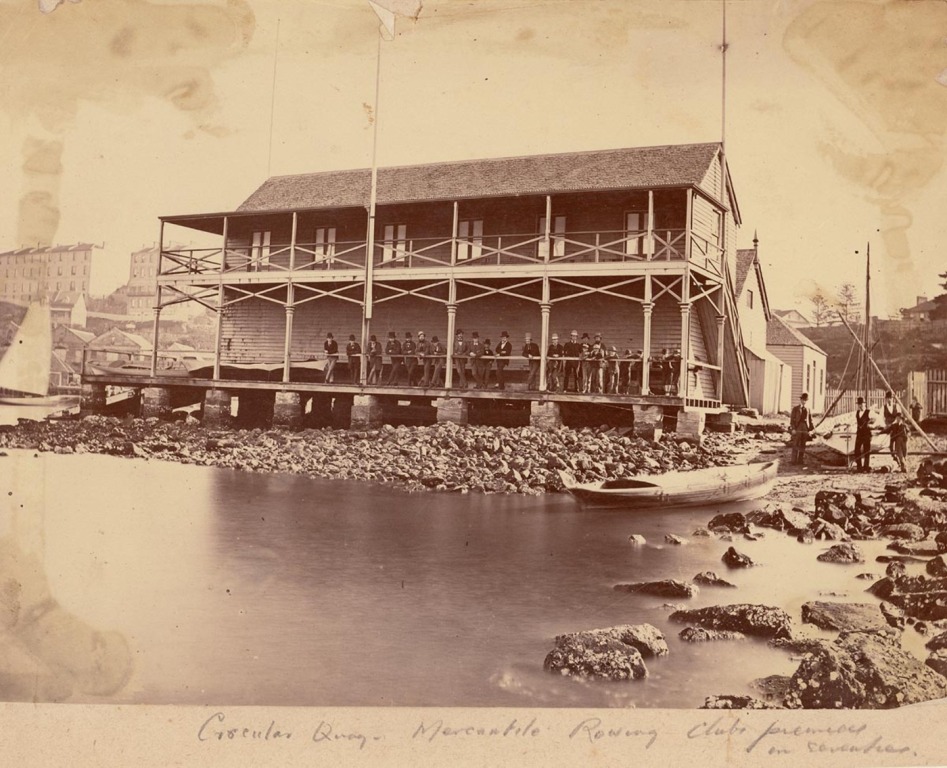
Mercantile Rowing Club at Dawes Point, ca. 1875 - The club formed in 1874 and secured premises at Dawes Point where a boatshed was erected. In 1911 the boathouse was pulled down and re-erected in Mosman Bay. -- Reference: Sydney rows : a centennial history of the Sydney Rowing Club / A.L. May. Abbotsford, N.S.W. : Sydney Rowing Club, 1970. Image No.: a089106, courtesy State Library of NSW.
The first inter-colonial rowing race held in Sydney:
THE INTERCOLONIAL ROWING MATCH.
The event depicted in our illustration took place at Sydney, on September 26, and had been the cause of much speculation for weeks beforehand. We abridge the following notice of the race from the Sydney Mail of October 3 : — Despite the difficulties which at first surrounded the attempt to bring about a meeting between the amateur oarsmen of New South Wales and Victoria, negotiations were brought to a satisfactory issue, and the announcement that the neighbouring colony had selected a crew worthy to represent her was received in Sydney with the liveliest pleasure. At the last moment, however, it seemed as if all our preparations had been made only to result in disappointment. Henderson, one of the best of' the Victorian quartette, was incapacitated by illness from going into training here, and Watson had to come over, a substitute. Fortunately, however, he was sufficiently recovered a couple of days before the great event to resume his old position as No. 2, and there was nothing to prevent the meeting of the rival crews save unforeseen casualty or unpropitious weather. Some of the Victorian supporters were inclined to deprecate any idea that the representatives of their. colony were worthy antagonists for the Fitzliardinges and Clarkes, but the general public and those who had been 'touting the training' were of opinion that it was to be a race from start to finish. The physique of the Victorian crew wan all that could be desired,' and, as they were located at Hyde, under the special charge of Eld ward*, their trainer, plenty of opportunity was given them of getting fit, although, no doubt, Henderson's indisposition may be said to have destroyed their chances. The Sydney crew trained under the supervision of Mr. G. H. Fitzbardinge, their captain. It is now nearly 12 years since Victoria put forward a claim in an intercolonial aquatic contest, and five events in which they were concerned have come off since then. Of these Sydney has won four. Their 'stroke' on Saturday last was coxswain of their first crew, and Las, therefore, taken part in all these intercolonial contests. The supporters and admirers of the Sydney crew (and of course there were thousands)were certainly not overconfident, for their calculations were so rudely upset by the utter defeat of our men in March last year, at Melbourne,' that it was not deemed prudent to speculate too freely on the coming event- As the day anxiously looked for approached, the opinion that the Sydney crew had' the best chance became stronger, and they were backed at 2 to 1, which was the state of the betting at the start. At half-past 1 o'clock the rain ceased, and when it became evident that the weather had set in fine there was a rush for the Circular Quay, and the omnibuses which had been specially told off to convey passengers from the suburbs to the wharf were crowded. At the Manly Beach steamers' wharf the following, steamers were lying—namely, the Hunter, Breadalbane, Royal Alfred, Phantom, Pelican, and Sir Charles Cowper, and opposite the Sailors' Home the Thetis, Ballina, Goolwa, Manly, and Leipoa. The umpires' steamer Achilles took in her passengers at the North Shore Ferry stage, on the other side of the quay. The fast little steamer Achilles had a considerable number of passengers, including the Hon. Henry Parkes (Colonial Secretary), the Hon. G. A. Lloyd(Colonial Treasurer), the Hon. Julius Vogel (Premier of New Zealand), the Hon. Thomas Russell (of New Zealand), and Messrs. S, C. Brown and J. Booth, M.L.A.
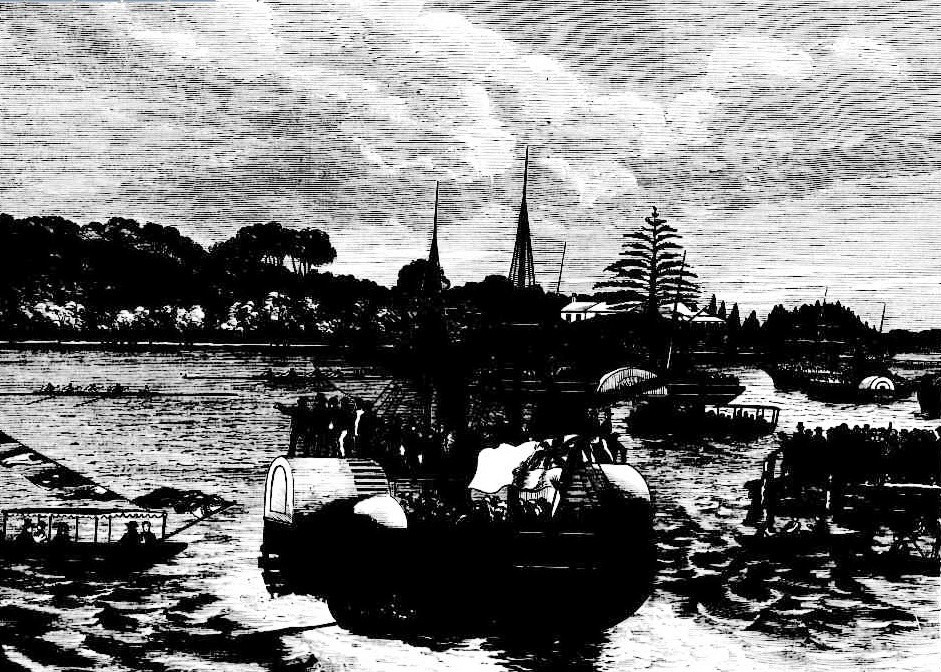
The first steamer to get away was the Hunter, which was quickly followed by the Sir Charles Cowper, Royal Alfred, Goolwa, Bungaree, Ballina, Breadalbane, and Achilles in the order named, a number of smaller steamers starting soon afterwards. Bounding Dawes Point the water was found to be somewhat bumpy, and a brisk breeze from the north-west Rave the rowing boats (of which there were comparatively few) plenty of work to get along, although the occupants worked strenuously in their anxiety to push up the river in time for the finish of the race. Passing Blue's Point the passengers on hoard the steamers were treated to a picturesque display of bunting, evidently run up by some enthusiastic resident in honour of the occasion. At the Sydney Rowing Club's branch establishment there was a similar exhibition, and there were several hundred people on the adjoining point, from whence the termination of the con test could be seen.
As soon as Ryde was reached the steamers took up the positions assigned to them by special order of the Marine Board, and the water police boat, in charge of Senior-sergeant Ferris, attended to the duty of keeping the stream clear of sailing boats and skiffs. With the exception of the Ballina, all the steamers were crammed from 'stem to stern,' and the bridge and paddle-boxes of each, were simply packed. Taking the passengers who were afloat, and the hundreds who were waiting ashore in eager expectancy, there could not have been less than 5,000 persons present; and it is satisfactory to know that, notwithstanding the indescribable excitement, and the risk that the smaller craft ran of getting in the way of the steamers, no serious accident has up to the present time been reported. The volumes of smoke from the steamers as they swept down the river caused some confusion, and considerably interfered with a good view of the race ; but this, of course, was unavoidable. During the time the race was progressing, the scene on the river was one of exceeding interest. . As the boats passed,, the steamers followed them at a respectful distance. Amongst these were, the Thetis, Breadalbane, Royal Alfred, Goolwa, Hunter, Ballina, Sir C. Cowper, and Bungaree, all loaded with passengers, who gave evidence of the intensest excitement, though it is worthy of remark that the cheers were given in encouragement of the Melbourne crew quite as often as they were given to that of Sydney. What with the crowds of persons that lined the shore, the steamers With their human freights, part of whom were hanging about from yards and spars and every obtainable point of vantage, and the river black with boats of every description, the scene was one that perfectly baffled description, whilst never before has the old river heard such a shout as that which went up when the Sydney crew stretched past— the winning boat. Before proceeding to give the details of the race, we must mention that Mr. W. O. Gilchrist officiated as umpire, and Mr. Q. Deloitte as starter. Lady Robinson, with Mr. and Mrs. St. John, and a large party, followed the race in the steam-yacht Leila.
THE RACE.
At 25 minutes past 4 the Sydney 'crew' doffed their overcoats on the point opposite Hyde, and took their places in the new gig built specially for the race by Greenland, of Melbourne. They seemed in splendid condition — muscles well developed, and facial expression indicative of a robust, thoroughly healthy course of training. Mr. G. H. Fitzhardinge, bow, weighed a trifle under list. ; Mr. P. J. Clarke, No. 2, list. 13lb.; Mr. R. A. Clarke, No. 3,list. 101b. ;*Mr. M. A: Fitzhardinge, stroke,,llst.8lb.; L. M'Kay, coxswain, 5st. Gib.
As soon as the umpire's 'steamer arrived, the Sydney crew started along the southern shore for a preliminary breather, pulling about 34 strokes per minute. They were off the starting point at Mr. Bowden's bathing-house ere the Victorians were seen descending the road leading to the old pier at Ryde, where they launched their gig, but, as it was a lee shore, were compelled to have her towed across the river, and take their seats there. This occasioned so great a delay that Mr. Fitzhardinge had to keep his crew paddling about to prevent them getting chilled, and it was not until five minutes past 5 o'clock that the Victorians pulled to the starting-point. The crew consisted of J. F. Edington, bow 8st. 131b.; H. W. Henderson, No. 2, 10st. 12lb. ; L. Kickham, No. 3, 12st. ; Z. Giles, stroke, 10st. 121b.; J. Edwards, cox., 4st 6lb. Very little time was lost in taking up positions, Sydney having the northern shore; and Melbourne the outside. The stiff north-west breeze, though fair for the race, had raised quite a ripple on the water, and the young flood was running up strong when the starter sent the gigs away dead level. Sydney, first to catch the water, went oft* at about 36 strokes per minute, Giles pulling a trifle faster ; but his men, too low on the feather for anything like broken water, seemed flurried for a few strokes, then, putting on a spurt, held their opponents for about 200 yards— Fitzhardinge's four rowing along powerful stroke, then steadily drew ahead, getting a clear lead before they had traversed half the distance to Kissing Point.
At this place the steering of the Melbourne gig seemed most erratic, owing to the slight hold the rudder had on the water —indeed, sometimes when the after section of the boat rose on a wave the steering gear was quite useless. To a close observer Mr. Henderson's right arm appeared to have given way before reaching Lang's Point, and nothing but an accident could prevent Sydney regaining the lost championship, In vain Giles, working like a tiger, put it on to 38 a minute; he seems to have to pull all on that side of the boat himself, as the rudder is almost hard across. Mr. Fitzhardinge's men are drawing away every stroke, rowing well within themselves. The injunctions of the Marine Board were ignored by the steamer Bungaree and a steam-launch flying the E. and A. Mail Company's flag, both of which gave the boats' crews the benefit of a- wash as they pulled down the long reach across the mouth of Hen and Chicken Bay. Melbourne misses a stroke as if fearful of being swamped, then away again in chase of their leaders, only to get served worse by the steam-launch Bonita running such a sea on to them that the coxswain slewed his boat out of her course to save being filled, but a hearty chorus of groans which rang out from the Achilles caused the offending steamer to clear out of the way. Sydney steered the correct course to got out of the tide when making for Looking-glass Point, Melbourne keeping full in the tide, and the same as they pulled thence to Gladesvillle. Here Sydney took the south shore, and rowed by their club-house at 37 per minute. They eased a little rounding the point, and then on the home stretch made for the stake boat with a telling 30, finishing at their ease in 21m, 50sec, amidst loud cheers, an equally high compliment being paid to their competitors, who were beaten 20 lengths, for the plucky manner in which they had rowed a stern race. –The result was at once despatched to Sydney by carrier pigeons. We omitted to mention that the Victorians rowed in a boat built by Edwards, and of the two gigs we believe she is faster than the Sydney boat in smooth water. Sketches. (1874, October 31). The Australasian Sketcher with Pen and Pencil (Melbourne, Vic. : 1873 - 1889), p. 118. Retrieved from http://nla.gov.au/nla.news-article60605617 - INTERCOLONIAL GIG RACE AT SYDNEY. ILLUSTRATION[No heading]. (1874, October 31). The Australasian Sketcher with Pen and Pencil (Melbourne, Vic. : 1873 - 1889), p. 113. Retrieved from http://nla.gov.au/nla.news-page5985647
Sounds as though these early ferries could have had their own race that day – if the Parramatta River could have allowed them the width to do so. We hope this small insight makes you want to hang on to your boating memorabilia, and all the stories that go with such items.
If you want to get involved in this years Pittwater Festival Surf Boat Shoot, details our now available on their website and for spectators, the 2015 races will take place on Saturday March 28th.
See you on the beach next Saturday for the last row and wave shoots of this year's SLS SNB surf boat races!
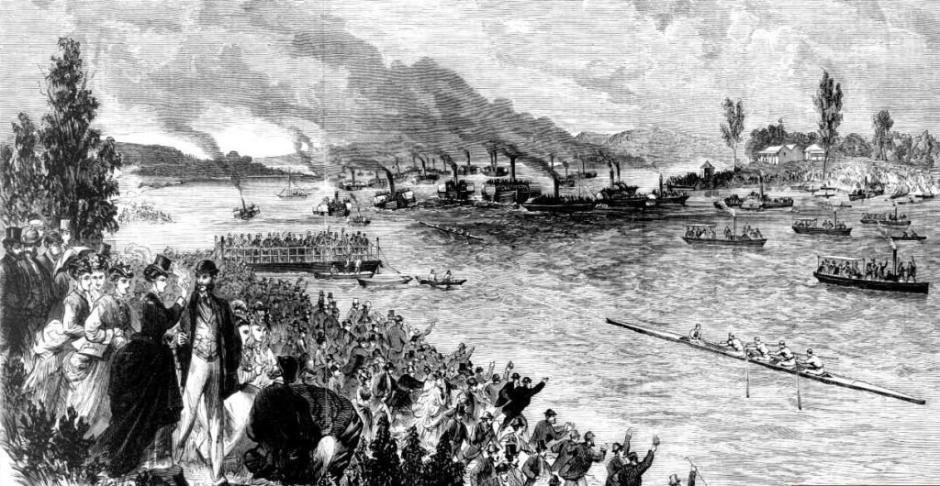
CHAMPION GIG RACE— NEW. SOUTH WALES. V. VICTORIA— PASSING THE SYDNEY ROWING CLUB'S NEW BOAT SHED. CHAMPION GIG RACE—NEW SOUTH WALES. V. VICTORIA—PASSING THE SYDNEY ROWING CLUB'S NEW BOAT SHED.
The subject of one of our sketches this month is in connection with the sixth Intercolonial gig race for the championship of the colonies .The first of these contests was rowed on the Parramatta River in 1863 , the next was at Tasmania in 1870, followed by two at Balmain in 1870 and 1872 respectively'; then by one at Melbourne in 1873 ; and last by the one just over: and with the exception of the race rowed in Melbourne, Sydney has always occupied the premier position, - Melbourne competing against them in five of the events. This last race was rowed on the Paramatta River, on Saturday, the 24th September, in the presence of an assemblage the like of which was never before seen at any aquatic contest, something like twenty one steamers crammed with passengers, accompanying the race, including the Government launch with Lady Robinson and suite on board, every point of advantage for witnessing the race also being crowded with its eager throng of spectators, the total number present being estimated at least at 15,000. This race was the outcome of a challenge accepted by the Melbourne Regatta Committee some time since from the Sydney Rowing Club, who were anxious to retrieve the laurels lost at Melbourne in 1873, whereby they offered to row Victoria for the championship of the colonies. The Sydney crew — composed of Messrs. M. A. H. J Fitizhardinge, stroke,11 st. 31b. ; R. A. Clark, 3, 12st. 1 1 lb. ; P. J.Clark, 2, 12 st. ; and G. H. Fitzhardinge, bow, … went into training almost immediately after the challenge was accepted, and up to the time of the race, according to the statement of the stroke made at a public dinner given to the crews after the race was over, they rowed over COO miles during their training to enable them to row this race properly. The crew for some time before the race were living at and training from the branch club house, a property purchased by the club, having a fine commodious house and extensive grounds. ..for the convenience of members when training for regattas, and as usual with them came to the post fit to row for their lives. The Victorian crew was not formed until about the begining of August,, and was, as -follows : — Z. Giles stroke, 11 st. 21b.; L.Kiokham, 3, 12 st. 41b.; H. W. Henderson, 2, 11 st. 10 lb. ; and J. F. Edington, bow»..n,l, st. lib. .(1874, November 4). Illustrated Australian News for Home Readers (Melbourne, Vic. : 1867 - 1875), p. 185. Retrieved from http://nla.gov.au/nla.news-article60446961
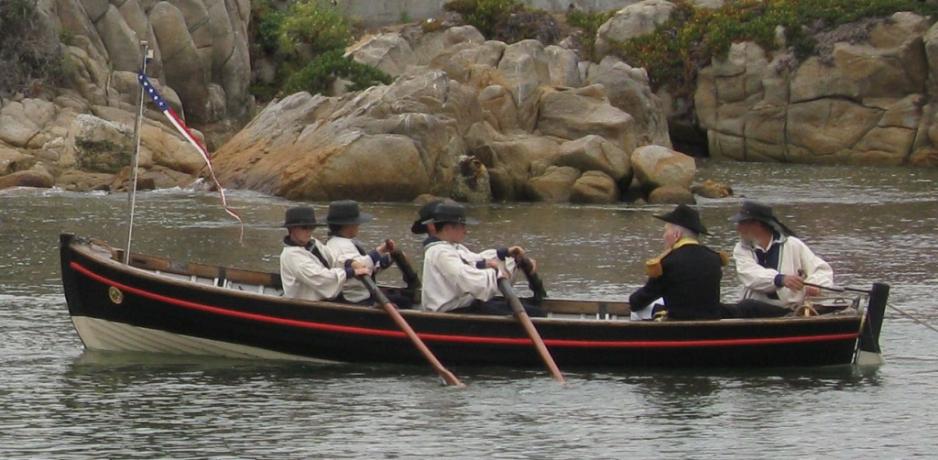
A four-oared Russian Navy Gig (Gichka) of Boat Base Monterey re-enacts the landing of Captain Mervine during the annual Sloat's Landing ceremony in Monterey, California, 2013 – photo courtesy Ltkizhi - Own work
Extras and references:
2015 Pittwater Festival
Classic Yacht Regatta
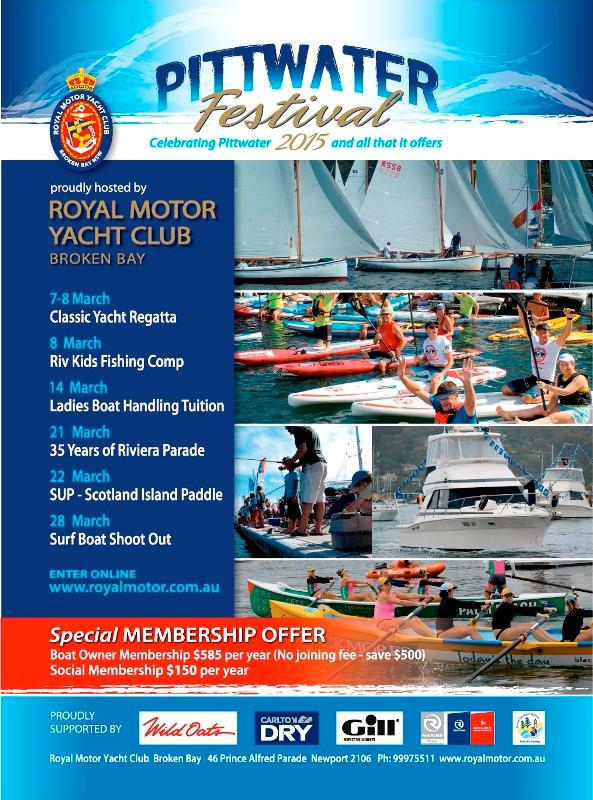 Saturday/Sunday March 7th/8th
Saturday/Sunday March 7th/8th
It is on again when we celebrate Pittwater and all that it offers through an array of aquatic events. Kicking off the festival this year will be the Classic Yacht Regatta. Over 60 yachts are expected; from all different eras competing over the weekend March 7th and 8th. A combination of scratch and handicap races across the various divisions, with a Parade of sail race to round of the regatta where all yachts will against each other. All of the yachts will be on display at the RMYC over the weekend in the morning and evening.
Stand Up Paddle –Scotland Island Race & Expo –Sunday March 22nd
One of the most exciting and successful events from last year was the Stand Up Paddle event. Of most interest was the 5 nm Scotland Island Race followed by the time trials back at the RMYC. For those wanting to try SUP, ideal facilities are on hand to do that and check out the EXPO where all the SUP gear is on exhibit. Families are invited to come down and take part or just enjoy the festivities here at the club where there will be entertainment and jumping castles. You can try stand up paddle boarding or just watch the sprint time trials in the mariner.
Power Boat & Fishing Events
R Marine Riley, Pittwater’s Riviera Motor Yacht Dealership once again will be organising an array of power boat events including the:
RMYC Pittwater social Raft Up - Saturday February 28th
RIV KIDS Fishing Competition - Sunday March 8th
Ladies Power Boat Driving Lessons - Saturday March 14th, with High Tea … a must for the ladies!
35 Years of Riviera Boat Parade - Saturday March 21st.
Riviera has been producing motor Cruisers for 35 years and each of their models will be on display in the parade and also back at RMYC Broken Bay
Surf Life Saving – Surf Boat Shoot Out
Short Course Sprint Racing – Saturday March 28th
The last event for the festival will be attracting crews from 15 Northern Beaches Surf Live Saving Clubs. Men’s and women’s events are held right in front of the outer marina, which provides the perfect viewing platform for the Surf Boat Shoot out. Crews will race the clock in the two boat heats with the fastest teams making their way through to the finals. You will never get closer to a Surf Boat Race than this!
Check out all the details on our website for more details www.royalmotor.com.au
References:
1. Wooden captains' gigs
In general, during the era of wooden ships, a gig was smaller and lighter than the longboat, barge or pinnace. It was usually crewed by four oarsmen, and a coxswain. Generally the oarsmen sat one to a seat, but each only rowed a single oar on alternating sides. The gig was not as sea kindly as the longboat, but was used mostly in harbors.
The gigs generally had a high wineglass transom, full skeg, full keel, straight stem and somewhat rounded sides. There was in general very little rocker in the keel. The gunwales on many were nearly straight from bow to stern. It appears[to whom?] to be the precursor to the Whitehall Rowboat. Some wooden captain's gigs were quite large and were powered by sail.
Other Boats you can Row
Dinghies usually range in length from about 2 to 6 m (6 to 20 ft). Larger auxiliary vessels are generally called tenders, pinnaces or lifeboats. Folding and take-down multi-piece (nesting) dinghies are used where space is limited. Some newer dinghies have much greater buoyancy, giving them more carrying capacity than older boats of the same size.
Whaleboats are among the classic "pulling" (rowing) boats, with a sharp bow, fine stern lines and a canoe stern. Despite being somewhat more tippy, with less cargo capacity than prams, they row, motor and sail well because of their fine lines. Prior to the introduction of fibreglass as a construction material, dories were more popular because their ease of assembly and, thereby, lower cost.
Whitehall Rowboats were the water taxis of the late 1800s until the invention of the small gasoline outboard. Considered one of the most refined rowboats for harbour and lake use, Whitehall Rowboats are a descendant of the captain's gig which was used for a similar purpose on a naval vessel.
Dories are sharp-ended boats traditionally made of wood but now also produced in fibreglass or aluminium. They cut the water well, but their initial stability is low, making them feel tippy in flat water; a loaded dory becomes more stable as it is loaded. Dories are not generally used as service boats to yachts; they were used in large numbers in the cod fishing business, launched in numbers from the deck of a schooner hove to on the Grand Banks or other fishing ground. A dory can be landed or launched through surf where a Whitehall may founder. Dories are seldom called dinghies.
Prams are usually short with transoms at both bow and stern. They are difficult to tip and carry a lot of cargo or passengers for their length but are slower to row because of their short length and extreme rocker, although a skeg and/or bilge runners can make a difference, and even without they will row better than an inflatable.
A four-oared Russian Navy Gig (Gichka) of Boat Base Monterey re-enacts the landing of Captain Mervine during the annual Sloat's Landing ceremony in Monterey, California, 2013 – photo courtesy Ltkizhi - Own work
Captain's gig. (2014, July 25). In Wikipedia, The Free Encyclopedia. Retrieved from http://en.wikipedia.org/w/index.php?title=Captain%27s_gig&oldid=618461430
2. Martha Rutledge, 'Thornton, George (1819–1901)', Australian Dictionary of Biography, National Centre of Biography, Australian National University, http://adb.anu.edu.au/biography/thornton-george-4720/text7827
3. History of Australian Rowing by Guerin-Foster (website) at: www.rowinghistory-aus.info/club-histories/sydney
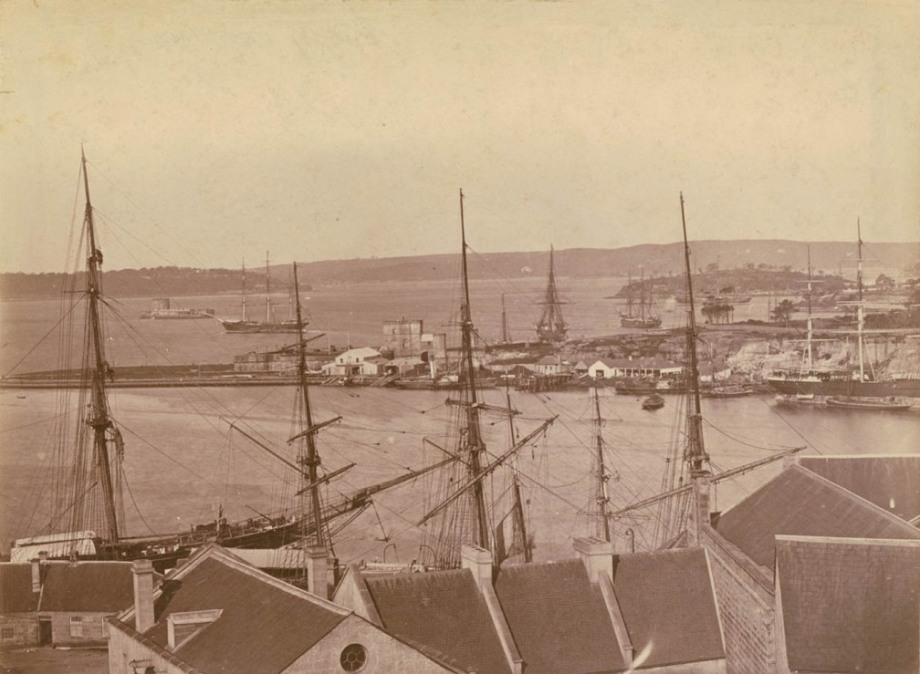
 (1).jpg?timestamp=1686944718431)
Cuthbert's Ship Building Yard : Sydney, New South Wales : photographed by Freeman Brothers. Courtesy Australian National Maritime Museum and State Library of NSW - Object no. 00028442 and d1_19777
Previous Collectors Corner pages:
Blacksmiths and Tinsmiths Nylon Stockings Poster Art Furphy's Water Cart Mousehole Anvil Sapphire One Armed Bandit Gould's 1840 Single and Compound Microscope Tibetan Thangka Wheel Of Life Painting Cast Iron Seats Mabel Lucie Atwell Prints The Customs of Traditional Dining by Hans and Jenny Carlborg Albert Collins Landscape Boomerang Harmonicas Drinking: 18th Century Style Part I by H&J Carlborg Drinking 18th Century Style Part II by H&J Carlborg Fleece Shears Wood Case Crank Telephone 1803 Timepeice Vintage Guitars Milestones No.38RollsRoyceMotorOiler Christmas Postcards Seashells McCormick-Deering Horse Drawn Mower Rope Making Machine Marilyn Monroe 1955 Calendar Stubbie Holders Hill's Hoist Akubra Hat Fowler's Bottling Kit The Bold Autographed Script Fishing Tackle Arnotts Biscuit Tins Comic Books Silver Opium Pipe Mrs Beetons Book Souvenir Teaspoons Bendigo Pottery Gianelli Figurines Key Fobs Model Aircraft-static Porcelain Slippers Wagon Wheels Rhys Williams Painting Chinese Guardian Lions Australian Halfpenny Bud Vases Rolling Stones Still Life LP Autographed WL1895 Thinking Monkey Estee Lauder Ginger Jar Reel Mowers Surf Reels Millers Car Collection Hilton Lingerie - Slips Miniature Books of Verse - A Romantic Tradition REGA Pouring Can R O Dunlop - Sailing At Itchenor Painting Morning Shadows by C Dudley Wood The Father of Santa Claus - Xmas 2012 HMS Penguin Anchor at RPAYC - Newport SS Birubi Mast at RMYC - Broken Bay Helen B Stirling Ship's Wheel at Club Palm Beach Woomeras HMSEndeavour Replica Cannon at RPAYC The Doug Crane Classic Handmade Double Blade Paddle HMS BountyWooden Ship Model Collecting Ladies - Ferdinand Von Mueller and Women Botanical Artists Australian Bark Art Chinese Ginger Jars Hand Plough and Jump Stump Plough - Australian Inventions Frank Clune Books Frederick Metters - Stoves, Windmills, Iron Monger Trinket Boxes 1933 Wormald Simplex Fire Extinguisher is Pure Brass Chapman 'Pup' Maine Engines - Chapman and Sherack The Beach Ball Figureheads – Salty Wooden Personifications of Vessels Binnacle at RMYC The Australian Florin - Worth More Than 20 Cents to Collectors Weathervanes; For Those Passionate About Seeing Which Way the Wind Blows Her Majesty’s Theatre 1962 Programme - Luisillo and his Spanish Dance Theatre Cooper's Sheep Shower Enamel Sign and Simpso's and Sons of Adelaide Jolly Drover Sugar Bowl and English Pottery – A Means to Gaze into the Past Chief Joseph and Edward S Curtis; His Remarkable Images of Native Americans – an Inestimable Record of Images and Portrait Photographs His Masters Voice, Old 78’s and Australia’s Love of Music Jack Spurlings 'Tamar' Picture 1923 Resch's Beer Art - A Reflection of Australiana Now Worth Thousands The Compleat Angler - Izaak Walton’s Discourse Inspires Generations of Fishers Portable Ice-Boxes and Coolers – How Many Claim This Invention as Theirs? Malley's and Sons Ltd. - A Munificent Australian Family Company
by A J Guesdon, 2015.